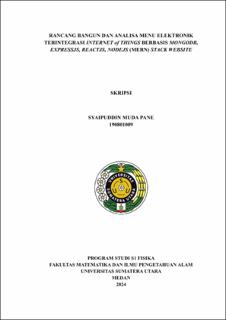Rancang Bangun dan Analisa Menu Elektronik Terintegrasi Internet of Things Berbasis Mongodb, Expressjs, Reactjs, Nodejs (MERN) Stack Website
Design and Analysis of an Integrated IoT Electronic Menu Based on the MERN (Mongodb, Expressjs, Reactjs, Nodejs) Stack Website

Date
2024Author
Pane, Syaipuddin Muda
Advisor(s)
Nasution, Tulus Ikhsan
Metadata
Show full item recordAbstract
In this digitalization era, technology and communication are rapidly advancing, even extending into the culinary field, requiring managers to compete in improving the quality of services provided. An electronic menu device integrated with the Internet of Things, based on the MongoDB, ExpressJs, ReactJs, NodeJs (MERN) stack website, was developed to facilitate the ordering process in restaurants and other dining places. This research also aims to analyze the impact of concrete barriers and humidity on Wi-Fi signal transmission and to identify the effects when the Wi-Fi signal strength is disrupted or weakened. Signal strength testing was conducted by adding concrete barriers around the device and measuring from distances of 5-30 meters with 5-meter increments, similar to measurements without concrete barriers. Additionally, the device was placed in a container with varying humidity levels ranging from 65%-95%. Finally, data processing speed tests for the MERN stack were conducted. This electronic menu uses Arduino Mega 2560 as the microcontroller, ESP8266 as the Wi-Fi module, DHT22 sensor for humidity readings, and a 3.5-inch TFT screen for user input. The results showed that concrete barriers could result in a gain or difference of 6 decibel milliwatts (dBm), and humidity above 93% could reduce the received signal strength by -12 dBm. Data processing tests showed that MERN has a much faster and more efficient performance compared to PHP + MySQL, with an insertion time of 3.83 seconds for 25000 rows compared to 98.76 seconds for PHP + MySQL, demonstrating a data insertion speed ratio of 1:26 times.
Collections
- Undergraduate Theses [1380]
